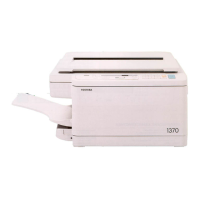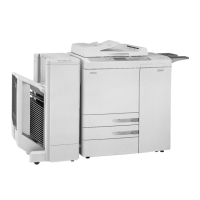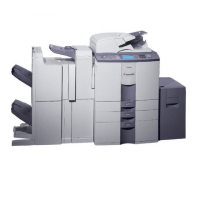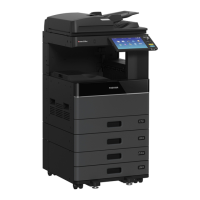
Do you have a question about the Toshiba FC-22 and is the answer not in the manual?
Precautions and steps for moving and setting up the copier.
Safety guidelines for servicing the copier, including handling high-voltage and rotating parts.
Identification of critical safety components like breakers, fuses, and thermostats.
Checking the presence and condition of important safety labels on the copier.
A comprehensive list of error codes, their classifications, and corresponding content for troubleshooting.
Procedure for using test mode 03 to check input/output signals.
Procedure for using test mode 04 to print test patterns.
Procedure for using test mode 05 for adjusting various items.
Procedure for using test mode 08 to set or change various items.
Procedure for automatically adjusting the auto-toner circuit.
Procedure for automatically initializing the image quality control system.
Adjustments related to copy image dimensions and alignment.
Procedure for automatically adjusting the gamma correction for image gradation.
Adjusting the center density and density variation for copy images.
Adjusting the color balance for copy images.
Adjusting the background density and text density for copy images.
Adjusting the judgment level for automatic monochrome/color identification.
Configuring AI mode discrimination and time-out settings.
Adjusting image sharpness for color modes and image modes.
Adjusting paper alignment to correct for paper buckle at the main registration roller.
Setting paper transport speed relative to image print speed for optimal output.
Adjustments related to printer output, including reproduction ratio and start position.
Adjustments for scanner image quality, including distortion and skew.
Overview of main and transfer high-voltage transformers and their outputs.
Procedure for inputting data after replacing main high-voltage transformers.
Procedure for inputting data after replacing the transfer transformer.
Procedures for installing and adjusting scanner carriage drive wires and positions.
Information on replacing and handling the lens unit, including screw locking.
Details on the two main types of preventive maintenance: General and Color maintenance.
Table showing how color copy ratios affect PM cycles for color maintenance.
Specific maintenance tasks and intervals for the FC-22 model.
Explanation of symbols used in the preventive maintenance checklist for FC-22.
Maintenance items for the Processing Unit, specifically black-related components.
Maintenance items for components located around the EPU.
Maintenance items for the Fuser unit, including rollers and sensors.
Color maintenance items for the Processing Unit, focusing on Y, M, C related parts.
Maintenance items related to image quality sensors and color registration.
Maintenance items for color registration components.
Maintenance items for the Laser unit.
Diagram showing the location of components within the Processing Unit (EPU).
Diagram showing the components of the Developer unit for Black (K).
Diagram showing the components of the Developer unit for Cyan (C).
Diagram showing the components of the Developer unit for Magenta (M).
Diagram showing the components of the Developer unit for Yellow (Y).
Procedure for cleaning the doctor blade, to be performed prior to developer removal.
PM Kit for FC-22, containing developer materials, for 30K copies.
PM Kit for FC-22, containing EPU parts, for 60K copies.
PM Kit for FC-22, containing Fuser unit parts, for 90K copies.
PM Kit for FC-22, containing Transfer Belt Unit parts, for 120K copies.
A jig used for keeping the door switch in an ON state during adjustments.
Jig used to hold wires to prevent unwinding during installation.
Adapter used for writing ROM data to the device.
Adapter used for writing ROM data to the device.
Sheet for reading X-Y coordinates in trimming and masking modes.
Jig used for adjusting the gap between the doctor blade and the sleeve.
Jig used for cleaning the doctor blade.
Brush used for cleaning various parts.
Color chart used for image quality and adjustment testing.
Jig used for adjusting the scanner carriage positions.
Guidelines for storing toner, developer, drums, cleaning blades, fuser rollers, and paper.
Procedures for checking and cleaning the OPC drum, including handling precautions.
Precautions for handling cleaning blades, emphasizing care to avoid damage and contamination.
Procedure for cleaning the blade edge with a moistened cloth.
Precautions for handling cleaning rollers, avoiding solvents and damage.
Precautions for handling fuser rollers, avoiding oil and hard objects.
Steps for checking fuser rollers, separation claws, and thermistor contact.
Procedure for cleaning fuser rollers, recommending warm cleaning.
Precautions for handling the transfer belt, avoiding touch, oil, solvents, and pressure.
Precautions for handling the transfer roller, avoiding touch, scratches, and dents.
Troubleshooting procedures based on specific error codes displayed by the copier.
Troubleshooting steps for paper jams occurring inside the copier, identified by error codes E01 and E02.
Troubleshooting for paper failing to reach the ADU, error codes E50, E51, E54.
Troubleshooting for paper jams within the ADU transport path.
Troubleshooting for original jams in the RADF, related to aligning sensor issues.
Troubleshooting steps for paper transport delays within the sorter, error EA1.
Troubleshooting steps for paper transport stops within the sorter, error EA2.
Troubleshooting steps for abnormal rotation of the ADU motor.
Troubleshooting for abnormal function of the ADU paper side guide.
Troubleshooting for abnormal function of the ADU paper end guide.
Troubleshooting for carriage home position sensor issues when not turning OFF.
Troubleshooting for carriage home position sensor issues when not turning ON.
Troubleshooting for abnormal rotation of the used toner transport motor.
Troubleshooting for thermistor or heater abnormalities during fuser warm-up.
Troubleshooting for thermistor abnormalities after the copier is ready.
Troubleshooting communication errors between the Main-CPU and Sorter-CPU.
Troubleshooting errors in ADF aligning sensor automatic adjustment.
Troubleshooting EEPROM initializing errors for the ADF.
Troubleshooting errors in ADF exit sensor automatic adjustment.
Troubleshooting procedures for abnormal Main-CPU operation.
Troubleshooting procedures for main memory abnormalities.
Troubleshooting procedures for abnormal IMC board connections.
Troubleshooting for abnormal rotation of the polygonal motor in the laser optical unit.
Troubleshooting for abnormal rotation of the sorter's transport motor.
Troubleshooting for image quality sensor abnormalities at the OFF level.
Troubleshooting communication errors between System-CPU and Main-CPU.
Troubleshooting communication errors between System-CPU and Scanner-CPU.
Troubleshooting communication errors between System-CPU and AI board during pre-scanning.
Troubleshooting image defects related to color deviation, including white voids and color blur.
Troubleshooting steps for color registration control errors.
Troubleshooting image defects caused by abnormal paper transport speed.
Troubleshooting image defects related to drum drive system issues.
Troubleshooting image defects related to the transfer belt system.
Troubleshooting image defects related to the laser optical unit.
Procedure for entering and operating the firmware version up mode.
Steps required on the PC to prepare for firmware updates, including software installation.
Details of the firmware version up mode screens displayed on the copier control panel.
Description of the system configuration required for PC-based firmware updates.
Instructions for setting up a virtual modem for dial-up networking.
Diagrams illustrating the AC wire harness connections within the copier.












